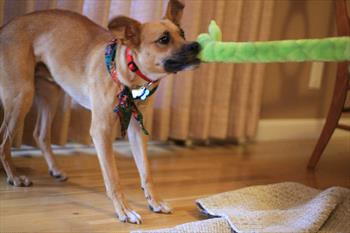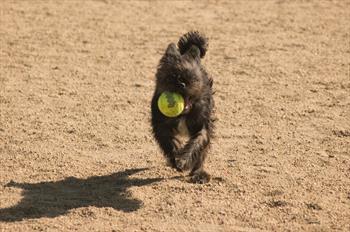Have you heard this statement from so many people that it seems like it’s an epidemic? “We had a Labrador mix when I was a kid and he was perfect. How come our new dog is so much harder? Is it the inbreeding?”
Or does the statement go more like this, “We got Lucky from the shelter and she’s so calm. Then we adopted Nero 2 years later as a playmate for her. He’s the same breed and age that she is, but he’s just hyper and crazy! We don’t know what to do with him!
The problem here is that while we humans realize that dogs come in more sizes and styles than Versace shoes, we often fail to acknowledge that dogs come with equally heterogenous personalities. So, if you’re looking for that perfect canine match, you’ll have to carefully evaluate your lifestyle and the amount of training you’re willing to invest, plus the characteristics of the dog. What types of characteristics as well as warning signs should you look for? Here are some tips.
Tip 1: A Passing Shelter Evaluation Doesn’t Mean a Perfect Pet.
Shelter evaluations are just a basic test meant to weed out the dogs that will be clearly difficult. Many dogs will slip under the wire or the problems will show up when they are in a more normal household environment.
Says one unlucky adopter, Tina Wang, whose dog Riley turned out to be fear aggressive to dogs and people, “The animal control officer told me that the officer who picked him up as a stray said Riley was really likable and gave him his kennel name. They don’t give them a name unless they like the dog. I did feel misled because Riley passed his behavior evaluation with flying colors. He got an A-, and the minus was because when they hugged him he leaned away. So from that, we just thought he was perfect except he might not be the cuddliest dog.”
Little did Tina know that the subtle behaviors Riley was showing that day and early on in her home were actually predictors that he was at risk for some serious issues. “We introduced him immediately to friends and family and he was not reactive. Two months after adoption, he lunged and snapped at my friend who was petting him while he was chewing on a bone. Since it only happened that one time, we figured it wouldn’t happen again, so we continued to let adults and children walk him and pet him. Every time someone came over, he would only bark for a few seconds, then be quiet and let people pet him.”
Tip 2: Being Non-Reactive is Not the Same as Being Friendly or Relaxed.
Problem is that Tina and company assumed that being-non-reactive was the same as being friendly or relaxed. They didn’t know to look for signs of anxiety or fear. If they had they would have realized that Riley was uncomfortable with unfamiliar people, especially when they bothered him when he was concentrating, such as when eating a bone. He was not aggressive to his close family in the same situations. If they had realized Riley had issues early on, they could have started him on a program to train him to associate unfamiliar people with pleasant experiences, instead of letting him have continued bad experiences leading to a level 1 pre-bite (snap and miss).
Even if you don’t have the training to recognize subtle signs of fear, some signs are pretty obvious if you stop to think about it. For instance, says Tina, “When Riley was first adopted, people would pet him and we didn’t see any signs that I can recall.” They didn’t know what to look for. But they did notice, that for the first year, when people came over, Riley barked and backed away as he barked. Then he would come up to guests when they were eating and allow petting, but says Tina, “he didn’t lean into it.”
Tip 3: Don’t Ignore the Obvious Signs of Fear.
Most likely Tina missed the signs of licking the lips, averting gaze, and yawning (See blog on signs of fear in dogs). But even if you don’t recognize that, barking and backing away are a dead give-away that it’s fear. Friendly dogs that just bark because there’s a change in environment and they’ve learned that barking is fun look relaxed once they are near the objects they are barking at. Then they solicit attention rather than backing away. Even when Riley got used to the people being over and was interested in their food, he only tolerated their petting him; he didn’t like it. Any sudden movement could have scared him and caused him to bark again.
Tip 4: Dogs Who Walk in An Overly Aroused Manner Are at Risk.
Not only did Riley have a developing fear of unfamiliar people, he was also reactive to unfamiliar dogs. “His hackles were raised every time he saw a dog on the street, big or small. He pulled and choked himself on walks and never paid attention to me.” Many people consider these high excitement behaviors to be normal for dogs; however, dogs that pull and walk in a hectic, hyperactive manner on a leash are showing lack of impulse control, which could develop into over-arousal and aggression. If you can’t get their attention back easily they are at risk for turning out like Riley.
In retrospect, Tina realizes that Riley was afraid outside. “Now looking back on it, he was so nervous that he wouldn’t even drink water outdoors even after a ½ mile bike ride. He never acknowledged my existence when we were outside.”
This is how his behavior started, but it progressed. States Tina, “Over the years, he just got worse and worse. His aggression escalated from barking to lunging to biting. I think we were always just thinking “maybe this time he’ll be ok,” and he never was. It just got worse.”
Tina finally found help and is working on a specific behavior modification plan but it’s been a learning curve. “I didn’t know he would be such a challenge, but we love him and wouldn’t ever return him. He’s been my best teacher yet.”
Tina admits that Riley lucked out. “I would not know what his fate would’ve been had he or other dogs like him been adopted by families who just wanted a normal dog!”
Tip 5: Look for a Dog that Calms Down Quickly.
That showed what to avoid, here are two cases of what you might want to look for in a dog you’re adopting. Throughout the years my dog class co-instructor, Melissa Morris, has fostered and brought a lot of dogs through our training doors, many of which have been incredibly easy. The most recent have been Gertie the black Brussels Griffon mix and Violet the Shih Tzu mix, both from the shelter.
Says Melissa, “I selected them because they were friendly and both calmed down easily.” Even though Gertie, a puppy, was really energetic, she had an “off switch.”
“She’d play for 5 minutes, then would be happy to sit next to you and relax,” says Melissa.
Violet, on the other hand, was just calm altogether. The first week she mostly lay in a dog bed, even when visiting a new location. She was just getting used to the new environments. By the second week, her personality blossomed. She followed Melissa around the house, happily greeting all people, and played in a relaxed manner with the many dogs she met, but lay down in the bed on cue and when Melissa asked her to settle down.
Tip 6: Dogs that Enjoy Attention, Petting and Praise are Easier to Train.
Both Gertie and Violet easily found homes and barely needed any training. Says Melissa, “When they are calm already, then they are easy to live with so you tend to have more patience with them in other situations.” Both Gertie and Violet also both automatically walked well on leash, sticking close to Melissa and rarely walking ahead or pulling. They even both already had a good come when called. They would both come running full speed when called even with minimal practice with food rewards. They both enjoy being with people and place a high value on attention, petting, and praise. Says Melissa, “The other day when Gertie was going to run up to greet a dog outside, I just called her and she immediately came running over without thinking.”
Tip 7: Evaluate Based on the Signs You See Not on How You Think the Dog Might Change.
While Melissa has been highly successful predicting which foster dogs will be easy for adopters to handle because she selects for behavior, Tina’s number one mistake is that she selected Riley primarily for his looks. She states, “He was good looking and we were looking for a dog around 25–30lbs. He fit the criteria.” They didn’t take his behavior into account. States Tina, “Although he didn’t beg for affection at the shelter, we just thought it was because he didn’t know us and that he would get more loving once he got more comfortable with us.” But Riley’s never become as affectionate as Violet and Gertie. He likes food and training but isn’t that motivated for petting, praise or attention.
Summary:
So, are you starting to see the patterns? Here’s a quick summary if you’re looking to adopt a dog who will easily integrate into your family and who won’t need tons of training:
- Choose a dog that’s relatively calm or that can calm down easily (within a second or two) and then lie down.
- Choose a dog who is interested in you and enjoys some praise and petting. That dog will naturally focus more on you.
- Choose a dog who is relaxed around unfamiliar people and dogs and shows signs that they enjoy their company.
- While the dog needn’t be perfect on leash, dragging in many directions can be due to anxiety or over-arousal and may indicate low impulse control.






